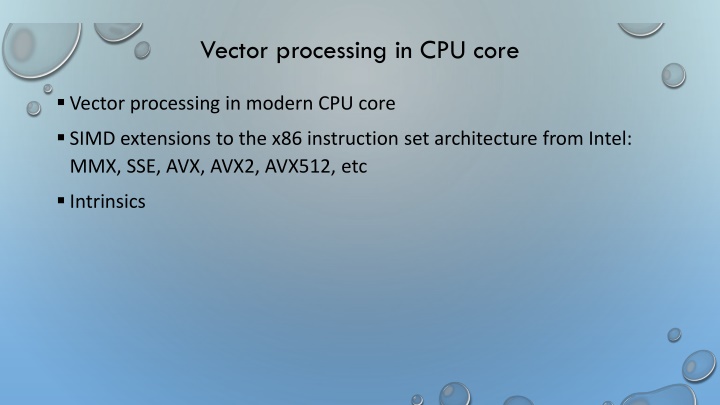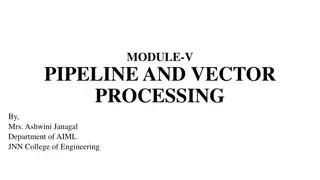An Overview of Vector Processing in Modern CPUs
SIMD architectures play a crucial role in enhancing the performance of vector operations in contemporary CPUs, with Intel's MMX, SSE, AVX, AVX2, and AVX512 extensions catering to data parallelism. Vector operations involve vector addition, scaling, and dot product computation, providing improved efficiency over scalar processing. Both AMD and Intel x86 processors support SIMD operations, utilizing various vector registers for enhanced processing capabilities.
Download Presentation

Please find below an Image/Link to download the presentation.
The content on the website is provided AS IS for your information and personal use only. It may not be sold, licensed, or shared on other websites without obtaining consent from the author.If you encounter any issues during the download, it is possible that the publisher has removed the file from their server.
You are allowed to download the files provided on this website for personal or commercial use, subject to the condition that they are used lawfully. All files are the property of their respective owners.
The content on the website is provided AS IS for your information and personal use only. It may not be sold, licensed, or shared on other websites without obtaining consent from the author.
E N D
Presentation Transcript
Vector processing in CPU core Vector processing in modern CPU core SIMD extensions to the x86 instruction set architecture from Intel: MMX, SSE, AVX, AVX2, AVX512, etc Intrinsics
SIMD architectures A data parallel architecture Applying the same instruction to many data o SIMD and vector architectures offer higher performance for vector operations. o SIMD logic has been built in contemporary CPUs. Check /proc/cpuinfo, look for mmx, sse, avx.
Scalar processing and vector processing Vector processing is a form of data parallelism o Same operation simultaneous executes on multiple elements of a vector.
Examples of vector operation + x y x y 1 1 1 1 Vector addition Z = X + Y + x ... y ... x y 2 2 2 2 + = ...... for (i=0; i<n; i++) z[i] = x[i] + y[i]; + x y x y n n n n * x a x 1 1 Vector scaling Y = a * X * x ... a x 2 2 = * a ...... for(i=0; i<n; i++) y[i] = a*x[i]; * x a x n n x y 1 1 Dot product x ... y ... 2 2 = + + + * * ...... * x y x y x y 1 1 2 2 n n for(i=0; i<n; i++) r += x[i]*y[i]; x y n n
Scalar processing .vs. SIMD processing ? = ? + ?: For (i=0;i<n; i++) c[i] = a[i] + b[i] ? 9.0 8.0 7.0 6.0 5.0 4.0 3.0 2.0 1.0 ? Scalar + 10 9.0 8.0 7.0 6.0 5.0 4.0 3.0 2.0 1.0 1.0 1.0 1.0 1.0 1.0 1.0 1.01.0 ? 5.0 1.0 6.0 2.0 7.0 3.0 8.0 4.0 ? ? SIMD + + + + 6.0 2.0 7.0 3.0 8.0 4.0 9.0 5.0 1.0 1.0 1.0 1.0 1.0 1.0 1.0 1.0 ?
x86 architecture SIMD support Both current AMD and Intel s x86 processors have ISA and microarchitecture support SIMD operations. x86 SIMD support o Intel: MMX, SSE (Streaming SIMD extensions), SSE2, SSE3, SSE4, AVX (Advanced Vector Extensions), AVX2, AVX512 See the flag field in /proc/cpuinfo o AMD CPU supports most, but a bit behind. No AVX512 yet? Micro architecture support o Many functional units o 64-bit, 128-bit, 256-bit, 512-bit vector registers
Intels SIMD extensions MMX (1997) o 64-bit vector operations o Data types: 8-, 16-, 32-bit integers SSE (Streaming SIMD Extensions, 1999) o 128-bit vector operations o Data types 8-, 16-, 32-, 64-bit integers 32- and 64-bit floats AVX (Advanced Vector eXtensions, 2011) o 256-bit vector operations AVX-512(2016) o 512-bit vector operations [Klimovitski 2001]
Microarchitecture support for SIMD processing 1-per cycle 64-, 128-, 256-, 512-bit operations (multiply, add, shuffle) Fast loading data from cache to vector registers
-O3 or -ftree-vectorize How to use vector extensions? Many levels o Use vendor libraries (e.g Intel MKL library) o Compiler automatic vectorization feature (mostly in vendor compilers) o Use vector intrinsics Like functions that can be called in C/C++ programs o Assembler code o gcc has automatic vectorization support. O3 or ftree-vectorize and mavx Not able to see any differences in my program.
SIMD assembler instructions Data movement instructions o moving data in and out of vector registers Arithmetic instructions o Arithmetic operation on multiple data (2 doubles, 4 floats, 16 bytes, etc) Logical instructions o Logical operation on multiple data Comparison instructions o Comparing multiple data Shuffle instructions o move data around SIMD registers Miscellaneous o Data conversion: between x86 and SIMD registers o Cache control: vector may pollute the caches o etc
AVX assembler instruction examples MOVAPD Move Aligned Packed Double-Precision Floating-Point Values. ADDPD - Add Packed Double-Precision Floating-Point Values CMPPD - Compare Packed Double-Precision Floating-Point Values Double-precision floating point Packed Normal operation: MOV, ADD, SUB, AND, OR, CMP, etc
SIMD programming in C/C++ Map to intrinsics oAn intrinsic is a function known by the compiler that directly maps to a sequence of one or more assembly language instructions. Intrinsic functions are inherently more efficient than called functions because no calling linkage is required. oIntrinsics provides a C/C++ interface to use processor-specific enhancements oSupported by major compilers such as gcc. oDocumentation: Intel Intrinsics Guide (https://www.intel.com/content/www/us/en/docs/intrinsics- guide/index.html#ig_expand=481,957,133,27)
SIMD intrinsics Header files to access SEE intrinsics o #include <mmintrin.h> // MMX o #include <xmmintrin.h> // SSE o #include <emmintrin.h> //SSE2 o #include <pmmintrin.h> //SSE3 o #include <tmmintrin.h> //SSSE3 o #include <smmintrin.h> // SSE4.1 o #include <immintrin.h> // AVX, AVX2 Not all extensions are supported by all processors. Check /proc/cpuinfo to see what are supported. When compile, use msse, -mmmx, -msse2, -mavx (machine dependent code) o Some are default for gcc.
Data types Depending on the extensions used. o__m128: (SSE) 128-bit packed single-precision floating point o__m128d: (SSE) 128-bit packed double-precision floating point o__m128i: (SSE) 128-bit packed integer o __m256: (AVX) 256-bit packed single-precision floating point o__m256d: (AVX) 256-bit packed double-precision floating point o__m256i: (AVX) 256-bit packed integer o 64bit, 512-bit
Example intrinsic routines See Intel Intrinsics guide for more details Data movement and initialization o __m128d _mm_loadu_pd (double const* mem_addr): (SSE) load unaligned packed double- precision floating point o __m256i _mm256_load_si256 (__m256i const * mem_addr): (AVX) Load 256-bits of integer data from memory into dst. mem_addr must be aligned on a 32-byte boundary or a general-protection exception may be generated. Arithmetic intrinsics o __m256d _mm256_add_pd (__m256d a, __m256d b): (AVX) Add packed double-precision (64-bit) floating-point elements in a and b, and store the results in dst. See ex1.c and sapxy.c for examples.
High performance timer We have used gettimeofday() the precision is in microseconds o Sufficient most of the time. To get nanosecond precision, use clock_gettime() o The hardware tick counter, rdtsc, used to be good. No longer reliable. See ex1_clock.c and sapxy_clock.c for examples Compile sapxy_clock.c with gcc flags: -O2 , -O3 , and -O3 mavx , explain the timing results.
Data alignments Data alignment issue oSome intrinsics may require memory to be aligned to 16, 32 bytes. May not work when memory is not aligned. oSee sapxy1.c Writing more generic SSE routine oCheck memory alignment oSlow path may not have any performance benefit with SSE o See sapxy2.c
Matrix multiplication with SSE2 See lect9/my_mm_sse.c
Summary Contemporary CPUs have SIMD support for vector operations Vector extension can be accessed at high level languages through intrinsic functions. Programming with SIMD extensions needs to be careful about memory alignments oBoth for correctness and for performance.























